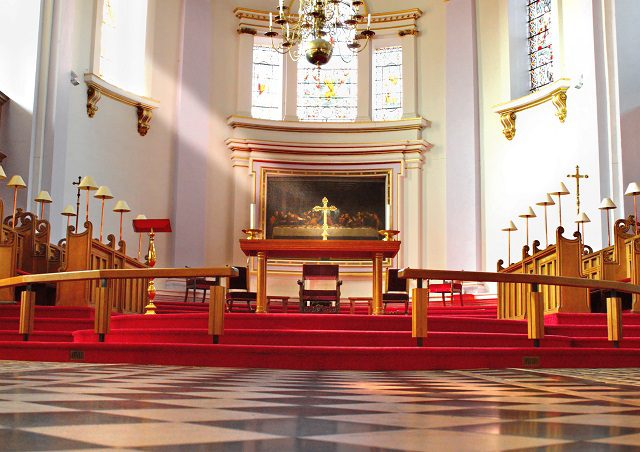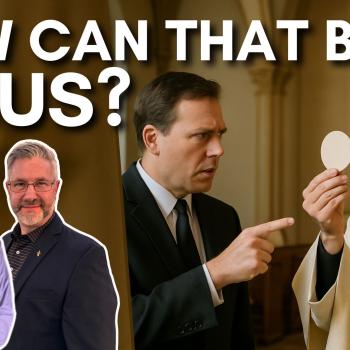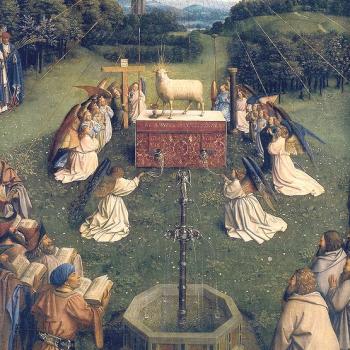
A pulpit is not an altar; it’s simply a table for sermon notes and Bibles. The front of the interior of a Protestant church is not an altar, either.
As an evangelical (from 1977-1990), I myself had little or no sense of the “altar” as a sacred place. I remember making arguments against Catholic friends that there was no such thing: that every place is equally sacred, because it is all God’s creation. The terminology of “altar call” is a remnant of Catholicism.
If one thinks all places and spaces are equally sacred, then of course, the front of a church would be included in that. But this misses the point. God is omnipresent, too, but it doesn’t follow that He is not present in a more profound way in the Eucharist and in a eucharistic chapel. Catholics believe in this sense of particularly sacred space precisely because we believe in the Real Presence and eucharistic adoration, and the Sacrifice of the Mass. The latter was vehemently rejected by all Protestants, save for a very few high Anglicans.
That is what “altar” — literally speaking, is about. It hearkens back to the Old Testament sacrificial system, Jesus as the Lamb of God, the table of the Lord (vs. the table of demons: St. Paul). Once that goes, the notion of “altar” is gutted. “Altar” doesn’t simply mean the place in front of the church where the pastor gives his sermon or where (in some churches) people come up to devote themselves to the Lord.
It’s much more than that. The term is still often used, as a carryover from Catholicism, but I think it is unfortunate because it entails a radical redefinition of what the word has historically meant.
It doesn’t follow that we are saying that no Protestants think anything is sacred, etc. No! Of course not. I wasn’t of that mind, and I dare say that few Catholic converts from Protestantism ever were, either. That’s not the point. Protestants believe in sacred space when they go to Jerusalem. They wouldn’t consider desecrating any of the holy sites. But in rejecting the traditional notion of the Sacrifice of the Mass, the altar goes, too, even if it is still called that.
Continuing Real Presence of Christ in a Catholic Church is why that space is sacred; why we genuflect; why we adore Christ in eucharistic adoration; why the sanctuary in front of the altar is a limited area during Mass, and treated with great reverence at all times.
That is not the case even in churches where the Real Presence is believed (traditional Lutherans and Anglicans), because they think the Presence ceases as soon as the service is over or after everyone receives communion. Protestants will respect the sanctuary area of their church but it is in a different sense; it’s not because they think Jesus is truly present there in a very special way. He’s only present in the sense that He is omnipresent in His Divine Nature. Since that applies to every place on earth and the universe, there is not all that much difference in the front of a church.
We see the Protestant aversion to altars in the sense I have described in, for example, John Calvin, where he writes “we know that the altars do cease, the sacrifices are abolished, whereof there was some use in time of the law . . . ”
There is no question that the Calvinist tradition (out of which large portions of the Baptist tradition is derived) scorned altars, and acted consistently insofar as altars and other Catholic items were often destroyed by Calvinist iconoclasts. This was true in the church in Geneva where Calvin preached (St. Pierre or St. Peter). Hence a web page about the church noted:
The Catholic cathedral of St. Peter became a Protestant church in 1536. John Calvin preached here from 1536 to 1564, and the cathedral became the guiding center of Protestantism. Like reformers all over Europe, Calvin’s followers stripped Geneva’s cathedral of its altars, statues, paintings and furniture. Only the stained glass windows remained. . . .
The nave is generally austere but warm, with a pleasing mix of Romanesque and Gothic architecture. The austerity is due to the former cathedral’s transformation into a Protestant Church in 1536. The Calvinists had little tolerance for religious images and any kind of excess, so they destroyed nearly everything but the bare architecture and whitewashed over the murals.
Fortunately, there were a few survivors of all this destruction – the stained glass in the chancel and the wonderful Romanesque capitals in the nave, which depict both human figures and a variety of mythical creatures.
The Lutherans didn’t do this. But the Calvinists did because they were iconoclasts, and part of that was considering an altar an idolatrous remnant of Catholicism. And that is because Catholics believed in the Real Presence and the Sacrifice of the Mass.
In an article about Calvin’s influence on the English “Reformation”, the following appears:
Add to this, that, according to the said Heylyn, the order for removing altars, and placing communion tables in their room, was chiefly owing to the influence of Calvin. “The great business of this year (1550) was the taking down of altars in many places, by public authority: which, in some few, had formerly been pulled down by the irregular forwardness of the common people. The principal motive whereunto was, in the first place, the opinion of some dislikes which had been taken by Calvin against the (first) liturgy.”
I even found a Baptist online who agrees exactly with what I am saying about how most Protestants view an “altar” in the full Catholic sense:
Baptist Altar-ations
In his post ‘Fads and Fixtures: The Seven Deadly Trappings of Evangelicalism’, Joe Carter writes that one of the fixtures he finds troubling is the altar call. While I too find the altar call methodology troubling, this brings up a larger question in my mind for my own denomination:
“Why do so many Baptist churches refer to the front of the church as the altar?
I’ve heard this terminology used in countless Baptist churches, even from pastors who should know better. The last time I checked, transubstantiation was not on any Baptist confessions of faith that I know of. Baptists believe that Christ was sacrificed once for all. In the Lords Supper Christ is not continually sacrificed, as Roman Catholics, the Eastern Orthodox, and others believe. We don’t burn offerings, and I haven’t really ever seen any kind of elevated structure other than a pulpit.
Its clear that in Baptist practice, the term altar has become synonymous with the front of the church sanctuary, but why do we retain the term? Were Baptists, after all. We don’t do altars. Can any of you more studious church historians enlighten me?
The Baptist view, along with that of many other evangelicals, is that since Christ was sacrificed once, it does not need to be re-presented, as you say. His sacrifice was presented to us once for the ages. In our view, this re-presentation is akin to re-sacrifice. After all, we would argue, why is there a need for an altar if there is no sacrifice?
Baptist Ken Blue makes basically the same point:
Having been saved and reared in Baptist churches all my life, it never occurred to me that much of what we do is steeped in tradition. We have borrowed these from Judaism and the Catholic Church. One of these is the so-called altar.
***
(originally 7-31-10)
Photo credit: [public domain / Pixnio.com]
***












